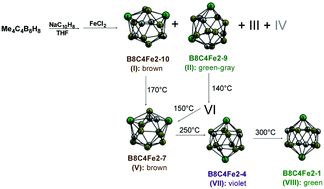Nonsphericity in diferratetracarbaboranes having 2n + 2 Wadean skeletal electrons: deviations from closo deltahedral geometries and high-energy kinetically stable isomers†
Abstract
The diferratetracarbaboranes Cp2Fe2C4Bn−6Hn−2 (n = 10 to 14; Cp = η5-C5H5) as well as the experimentally known C-tetramethyl derivatives Cp2Fe2C4Me4B8H8 have been studied by density functional theory methods. For the Cp2Fe2C4Me4B8H8 system, the three structurally characterized isomers produced under relatively mild conditions having an “open” tetragonal or pentagonal face correspond to the lowest energy structures not based on the 14-vertex closo deltahedron, namely the bicapped hexagonal antiprism. These structures provide examples of kinetically favored but thermodynamically disfavored high-energy metallacarborane structures. Thus the lowest energy such structure lies ∼22 kcal mol−1 above the global minimum, namely a C2vcloso structure with no C–C deltahedral edges. This latter global minimum 14-vertex closo structure is found experimentally to be the ultimate pyrolysis product in the Cp2Fe2C4Me4B8H8 system at 300 °C. The lowest energy structures for the smaller 11 to 13 vertex Cp2Fe2C4Bn−6Hn−2 systems are the corresponding most spherical closo deltahedra as expected by the Wade–Mingos rules for these 2n + 2 skeletal electron systems. However, for the 11- and 12-vertex systems, less spherical deltahedral structures providing additional degree 6 vertices for the iron atoms and degree 4 vertices for the carbon atoms become energetically competitive. For the 10-vertex Cp2Fe2C4B4H8 system a relatively non-spherical deltahedral structure with four degree 4 vertices for the carbon atoms and two degree 6 vertices for the iron atoms is energetically preferred by a substantial margin. Thus such a structure lies ∼23 kcal mol−1 in energy below the isomeric 10-vertex closo bicapped tetragonal antiprism structure expected from the Wade–Mingos rules for this 2n + 2 skeletal electron system.



 Please wait while we load your content...
Please wait while we load your content...